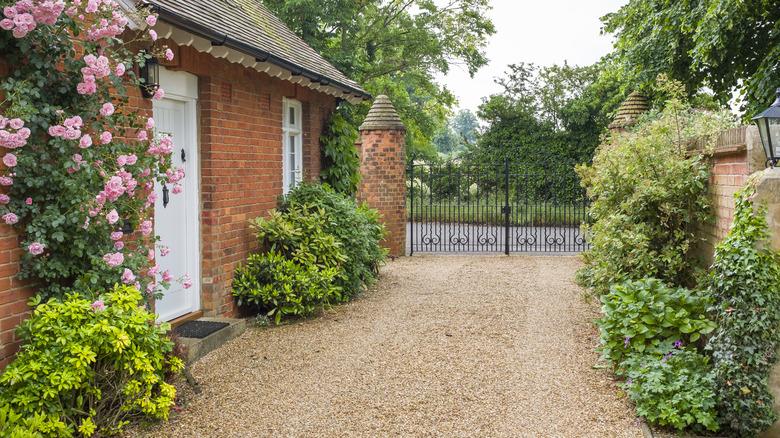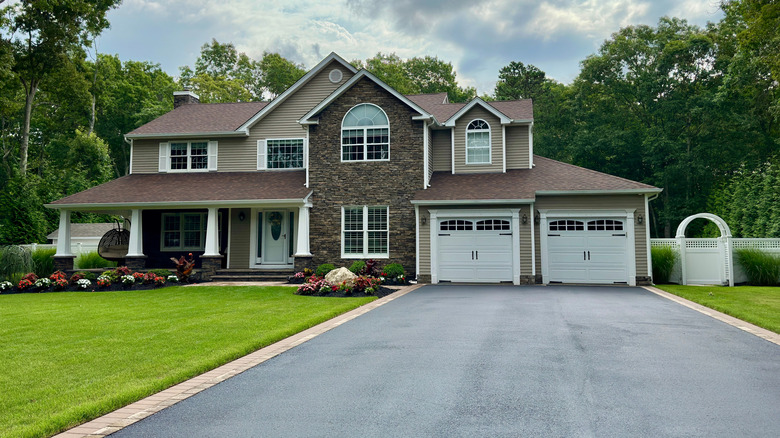Gravel Vs Asphalt Millings: How To Choose The Best Material For Your Driveway
Your driveway is your home's welcome mat. You can dress up your driveway entrance to make a good first impression, but even more important than how it looks is how it functions. Sure, a flashy driveway may improve curb appeal, but how much traffic can it handle before it needs maintenance? How well does it hold up to the elements? What's the most cost-effective choice?
When choosing the perfect material for your driveway, you have a few options, and two of the more affordable ones are gravel and asphalt millings (also known as reclaimed asphalt pavement). You probably already know what gravel is, but in case you're less familiar with asphalt millings, they're little recycled pieces of asphalt ground up from the top layer of an existing driveway. Those pieces get compacted and sealcoated to create a new, durable surface. So, which makes a better driveway, asphalt millings or gravel? Each comes with benefits and drawbacks, and it depends on how much you're willing to spend and how eco-friendly, durable, and low maintenance you want the new surface to be.
Pros and cons of gravel
Visually, the rustic charm and versatility of gravel can't be beat. You can even choose the color of your gravel, while asphalt millings will be limited to the color of pavement being recycling. Gravel is also one of the cheapest options for driveway materials, costing only $0.50 to $3 per square foot with installation, and setting it in place is relatively easy — so much so that dedicated DIYers may be able to knock out the project themselves. Gravel's loose pebbles allow for good water drainage, so you'll still get good traction on your driveway even on the rainiest days.
On the downside, that looseness makes the pebbles easier to displace, so you'll need more periodic upkeep for gravel than for asphalt millings. And this extra maintenance comes at a cost, so while you may be saving money on materials up front, the expenses can catch back up with you down the line. Gravel also isn't ideal for high-volume traffic or fast-moving vehicles, since driving over it too quickly can cause damage to both your car and the gravel surface.
Pros and cons of asphalt millings
One major asset of asphalt millings is their eco-friendliness. Since you're creating a driveway surface out of pre-existing asphalt, you need less new materials and help keep construction debris out of landfills. A 2018 report by the National Asphalt Pavement Association found that recycling 101.1 million tons of asphalt millings nationwide saved over 60 million cubic yards of landfill space.
Asphalt millings are also more durable, since they harden over time — unlike gravel or even hot asphalt. This quality makes them a low-maintenance option, with little to no sealcoating or resurfacing required. You'll also keep your car and its tires cleaner, since asphalt millings kick up less dirt than gravel. Saving on maintenance costs and car washes means more money in your pocket over time.
But while you stand to save money in the long haul, asphalt millings do cost more than gravel upfront, with a price tag of up to $5 per square foot, including installation. Because the surface is less permeable, it's more likely to accumulate standing water, which can get slippery. Its surface can also cause rainwater runoff. And while asphalt millings are sturdy, their robustness varies based on the quality of the pavement they're recycled from. The most significant deciding factor in choosing between gravel and asphalt millings is how often your driveway will be in use. Gravel is a great option for handling small cars and light traffic, but if your driveway is regularly supporting multiple heavy vehicles coming and going, asphalt millings may be the better bet.


